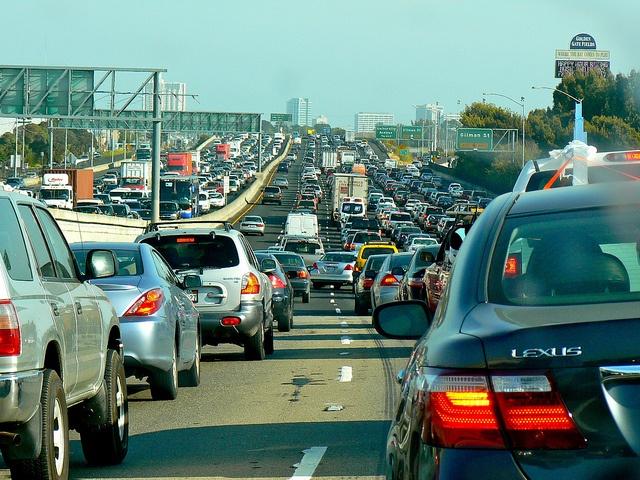
We often hear about the two Americas that defined this country over the past 20 years, as in the blue Northeast and West Coast separated by a sea of red in the middle and the South. But the truth is that any divides between Americans are not just political. The renewed urbanization in the U.S. also contributes to a massive economic divide. Wealthier citizens are now living in city centers and older suburbs, driving up real estate prices, while poorer (and often non-white) residents are moving to the exurbs and even rural areas, far from where they work.
The trends can be seen everywhere, from New York to D.C. to Los Angeles. But the San Francisco Bay Area is arguably becoming the most economically and culturally segregated metropolitan region in the U.S.
The definition of the Bay Area was once literal, but now it includes far-flung towns such as Los Banos, Modesto, Vacaville and Stockton, as more residents move farther out in their search for more affordable housing. With San Jose being the first city in the country to have a median home value over $1 million, the odds are high the entire region’s housing crisis will only become worse.
The results will be an area less diverse as it becomes less affordable. And in a world where much work can be done virtually, the long-term threats to Silicon Valley’s heft will grow as plenty of other cities offer both talent and a reasonable cost of living, from Reno to Eugene to Huntsville.
On that point, Urban Habitat, an advocacy group that represents low-income communities and people of color, issued a report highlighting what it says are growing inequities between the richer coastal counties and more remote and inland counties.
In a nutshell, Northern California has seen an ongoing exodus of black and Latino residents to rural areas since 2000. Many of these residents moved out of San Francisco, Oakland, San Jose, and their adjacent suburbs to remote areas in Contra Costa, San Joaquin and Stanislaus counties. The trend unfolded for years, as workers in sectors such as retail, foodservice and healthcare moved farther east.
The foreclosure crisis of 2007-2009, however, accelerated this demographic shift. And counties such as Solano, Stanislaus and Sonoma saw an increase in renter-occupied units. And while poverty in the Bay Area has overall decreased since 2000, several pockets in the region’s outermost reaches saw an increase in the local poverty rate. The roster reads like a list of what were once thought of as small country towns: Gilroy, Morgan Hill, Dixon and Antioch.
Urban Habitat offers plenty of data to back up its conclusion that far too many people are being squeezed out of the Bay Area housing market. The long-term implications are disturbing, as the reality is that many of the region’s profitable companies -- along with their high-income employees -- are also reliant on lower-earning workers for both their continued success and way of life. Whether they are the employees who do much of the grunt work for these companies and their contractors, or people who provide services for their families in the healthcare, education and child care sectors, there is no way the Bay Area’s economy in the can continue to rely on many of its workers spending up to four hours a day in a car or on a bus or train.
So, what are the solutions? The call for rent-control measures have caught fire across the Bay Area as local media reports of jacked-up rents and evictions stoked anger and pulled at heart strings. The problem with rent control, however, is that while it provides a safety net for those who are already living in this high-priced region, most economists agree that such laws do little, even nothing, to expand the pool of affordable housing for residents who lack it.
In the meantime, a region that prides itself on “diversity” will have a hard time finding people with whom to celebrate it as more residents give up on the struggle and just move away.
A patchwork of affordable housing programs are available, from San Francisco to Santa Clara. But demand far exceeds supply – and of course, that term “affordable” is relative. Living-wage ordinances are gaining momentum, but landing a $15-an-hour job will not make it any easier to even find a room to rent. A reform of the service industry could help make the Bay Area a more humane place for those earning lower wages. But until more aggressive tactics are taken to address the Bay Area’s housing problem, look for more residents to move to the San Joaquin Valley – and traffic to become even worse.
Image credit: Walter Parenteau

Leon Kaye has written for 3p since 2010 and become executive editor in 2018. His previous work includes writing for the Guardian as well as other online and print publications. In addition, he's worked in sales executive roles within technology and financial research companies, as well as for a public relations firm, for which he consulted with one of the globe’s leading sustainability initiatives. Currently living in Central California, he’s traveled to 70-plus countries and has lived and worked in South Korea, the United Arab Emirates and Uruguay.
Leon’s an alum of Fresno State, the University of Maryland, Baltimore County and the University of Southern California's Marshall Business School. He enjoys traveling abroad as well as exploring California’s Central Coast and the Sierra Nevadas.














